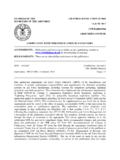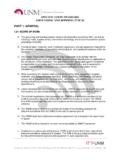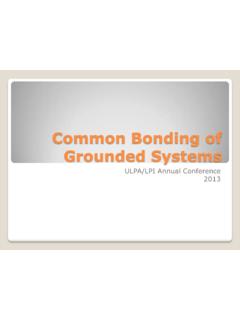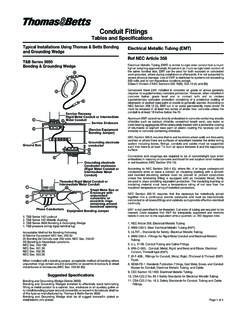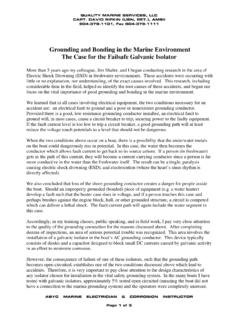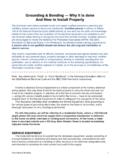Transcription of Improved Bonding and Grounding Methods for Electrical ...
1 Final Release Version, 1/23/2012 Improved Bonding and Grounding Methods for Electrical / Electronic Equipment NSRP Electrical Technologies Panel Project Report 23 January 2012 Prepared by: John Layman, Huntington Ingalls Industries DISTRIBUTION STATEMENT A. Approved for public release; distribution is unlimited. Final Release Version, 1/23/2012 DISTRIBUTION STATEMENT A. Approved for public release; distribution is unlimited. i Executive Summary Bonding and Grounding in accordance with MIL STD 1310, Shipboard Bonding and Grounding Methods for EMC and Safety, is time consuming and costly as currently applied.
2 During new ship construction, going to bright metal requires removing paint or oxidation from new equipment and foundations. Existing Methods are successful in that Bonding and Grounding are being accomplished with rare and isolated failures. This project was conceived under the belief that less expensive Methods for Bonding and Grounding may exist in either private industry or government shipbuilding. The goal of the project has been to investigate Methods and provide the Technical Warrant Holder with recommendations on how those Methods could be adopted throughout Navy shipbuilding.
3 A scientific approach was used to discover and review potential new Methods . The most promising were explored further to determine their potential application to Naval shipbuilding. The primary results are: It is recommended that the use of Grounding washers in place of cleaning to Bright Metal be allowed in selected applications and under selected controls. For future ship designs, adding a separate Grounding conductor, for individual Electrical components should be evaluated for its overall cost benefits. It is recommended that each shipyard explore pre-masking Grounding surfaces on Electrical foundations and Electrical equipment.
4 No blanket statement was possible, but a cost savings may be achieved under certain circumstances. Proposed changes to MIL-STD 1310H to accommodate these changes were developed and are presented in Attachment 4. Final Release Version, 1/23/2012 DISTRIBUTION STATEMENT A. Approved for public release; distribution is unlimited. ii Table of Contents Executive Summary .. i Background .. 1 Project Goals and Objectives .. 2 Study Participants .. 2 Study Process .. 3 Methods and Procedures .. 3 Vendor Survey .. 4 Review of Potential Improvements .. 5 Grounding Washer Effectiveness and Corrosion Study.
5 6 Conductive Sealant 7 Study Findings .. 7 Grounding Washer Effectiveness and Corrosion Study .. 7 Conductive Sealant 8 Pre-Masking Recommendation .. 8 Torque Study .. 9 Conclusions and Recommendations .. 11 Attachment 1: Team Member Contact Information .. 1 Attachment 2: MIL STD 1310 Version G and H 1 Attachment 3: Review of Conductive Sealants .. 1 Sealants and Adhesives Reviewed Against The Above Standards .. 6 Attachment 4: Proposed Change to MIL STD 1310 for Bonding and Grounding .. 1 Attachment 5: Commercial Contacts .. 1 Attachment 6 Torque Study.
6 1 Attachment 7: Washers Selected For Testing .. 1 Lock Washer, Ext, ID, PK 50 - Granger .. 1 Final Release Version, 1/23/2012 DISTRIBUTION STATEMENT A. Approved for public release; distribution is unlimited. iii Fastener Dimensions, Inc.. 2 The Panduit Internal Tooth B Twist Washer.. 2 ASKEW Industrial Corporation .. 3 Lock Washer, Internal/External Tooth, ID, PK100 - Granger .. 3 Attachment 8: Preparation of Lab Specimens .. 1 Cutting and Drilling of Test Specimens .. 1 Blast and Paint Test Specimens .. 1 Attachment 9: Test Plan for Bonding and 1 Attachment 10: Vendor Lab Report Findings (excerpts only).
7 1 Attachment 11: Test Sample Bonding Resistance and Notes and Observations from Samples after Testing .. 1 List of Tables Table 1 Washer Samples Being Tested in Torque Study .. 9 Table 2 Test Results Showing Electrical Resistance at Various Torques .. 9 Table 3 Washer Samples Being Tested in Torque Study .. 1 Table 4 Test Results Showing Electrical Resistance at Various Torques .. 2 Table 5 Profile of Participants .. 3 Table 6 Minimum Required Torque Produced by Participants .. 4 Table 7 Selected Test Items .. 2 Final Release Version, 1/23/2012 DISTRIBUTION STATEMENT A.
8 Approved for public release; distribution is unlimited. 1 Background Bonding and Grounding of Electrical equipment installed aboard U. S. Navy Ships must be accomplished to the requirements of MIL-STD-1310, Standard Practice for Shipboard Bonding , Grounding , and Other Techniques for Electromagnetic Compatibility and Safety. These requirements are well established as an effective quality and workmanship standard. However, compliance is time and labor intensive. Because of the large number of Bonding and Grounding events on each ship, in the tens of thousands, Bonding and Grounding contributes significantly to overall ship construction costs.
9 The objective of this project was to examine the effectiveness and cost efficiency of alternate materials and installation Methods . The Class A bond was considered to offer limited opportunities for process improvement. Class B and C bonds are used in the majority of shipboard Bonding applications and, were considered to offer the best opportunities to obtain cost savings through process changes. This study focuses on Class B and C bonds. During new ship construction, going to bright metal requires removing paint or oxidation from new equipment and foundations.
10 This is the most time consuming activity in Bonding Electrical equipment to its foundation. The goal of the project has been to investigate Methods to reduce Bonding and Grounding costs while maintaining the functional requirements of MIL-STD 1310. The process of a Class B Bond is summarized as follows: At least one mounting bolt hole/mounting foot shall be prepared for Electrical safety. All mounting feet/mating surfaces shall be prepared for C5 ISR equipment operation and EMI/EMP mitigation Bonding . Definitions Bonding - An Electrical bond is a conductive path between two metallic surfaces established by welding, bolting/clamping, or addition of a bond strap.


